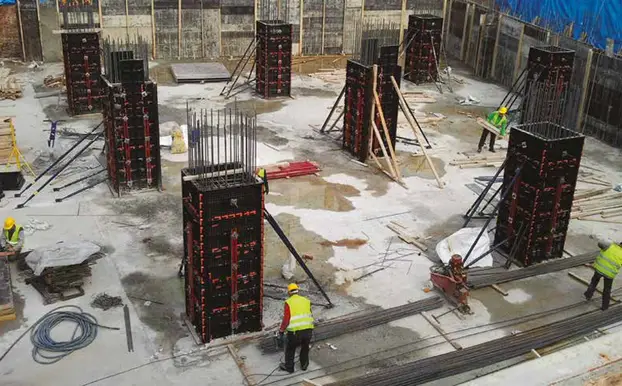A column is an upstanding pillar that supports a roof, standing alone monument, or other structures. colunas play a massive role in bearing the load from the peak of a building or monument to the bottom. Typically, columns are primarily vertical structure forms designed to support compressive loads impending from beams and slabs, then transmitted to the ground through the foundation. Columns are the most significant members of any standing structure. There are different types of building columns in construction. If not well built, weak columns can lead to a sudden collapse of a building, monument, or other structure. There are different types of columns, and let’s take a look at them.
- Types of Column Based on Reinforcement.
- Tied column is reinforced laterally with ties spaced roughly consistently across the column. The toughness of the concrete tied column can be upgraded by restoring the circular tie bar with the corresponding are steel plate. They are among the most common types of building columns in construction.
- Spiral Column is also known as the Solomonic column distinguished by a spiraling, twisting stem like a spiral.
- Composite Column is made using profuse combinations of structural steel and concrete to harness the valuable properties of each material.
- Types of Column Based on Loading
- Axially Loaded Column está sujeito a um carga axial when the center of gravity supported by the column corresponds with the line C.G. of the column in the longitude direction.
- Axially Loaded and Bi-axial Bending Column -bending influences columns where the load is irregular about both axes in the column’s plane.
- Axially Loaded and Uni-axial Bending Column– bending takes action on only one axis, unlike bending in bi-axial, which acts on two axis of a column
- Types of Columns Based On Shapes
- Square and Rectangular Columns have the same structural capacity. They are outlined to carry loads flawlessly, but square columns have four symmetry axes, and rectangular columns have two axes of symmetry. Both columns are affordable and mainly used in building constructions.
- Circular columns are too fitting for seismically vulnerable areas where strength and flexibility are needed in all directions. A circular column’s bending resistance is higher than that of a square or rectangle column because four or more bars are used as reinforcement. They are best for bridges and high-rise buildings.
- L Type Columns are mainly used in the corner’s boundary wall structures, and their features are like a rectangular or square column.
- Y Type Columns are widely used in holding on to wall constructions and bridges.
- Types of Column Based on Construction Material
- Composite Column is a combination of traditional structure that attempts to utilize the useful properties of each material. The regular types of composite columns are;
- Concrete filled tubes
- Fully encased composite column
- Partially encased column
- Coluna de aço is made of steel and steel frames usually are H sections, for the most part carrying axial load. They are among the most common types of columns in construction.
- Brick Column adds a classic touch to a building and can act as corner pillars, boundary gate pillars, porch columns, or free-standing columns.
- Madeira Column is mainly used in timber structures.
- Coluna de pedra is used to lessen settlement and increase load-bearing volume. Stone columns are also known for the acceleration of soil consolidation, thus useful in slope stability.
- Types of Columns Based on Slenderness Ratio.
- Coluna Curta– when the ratio of the column’s implied length to its slightest lateral proportions is less than 1.2, it is referred to as a short column. In short columns, mechanical failure may take place due to shearing.
- Coluna Longa– when the ratio of the column’s actual length to its slightest lateral dimension surpasses 12, the column is considered a long column. They are weaker than short columns and are likely to fail due to buckling.
